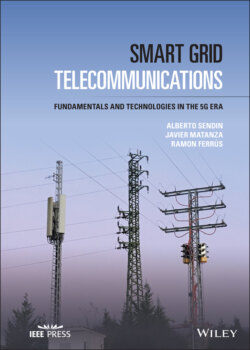Читать книгу Smart Grid Telecommunications - Ramon Ferrús - Страница 21
1.2.2.1.1.2 Distributed Generation/Distributed Energy Resources
ОглавлениеDG refers to the “utilization of small (0 to 5 MW), modular power generation technologies dispersed throughout a utility's distribution system” [7], i.e., small‐size generation that connects into the Distribution part of the system, as opposed to conventional centralized power generation systems. DER (sometimes shortened as DR or Distributed Resources) is literally “a source of electric power that is not directly connected to a bulk power system [… and] includes both generators and energy storage technologies capable of exporting active power to an electric power system” [8].
Although DG, DER, and DR are modern acronyms, the concepts they represent stem from the past [9] and refer to a basic smaller scale generation closer to Consumption Points. The novelty nowadays is that DG/DER/DR intends to be connected to the conventional grid as well and has the potential to be widely adopted across it. This wide adoption is based on their capability to reduce system losses and improve power quality and reliability, thus deferring Transmission and Distribution grid improvements [7].
US EPA (United States Environmental Protection Agency) reinforces the idea and points out the environment factors that the concept, when fully developed, involves [10]: “DG refers to a variety of technologies that generate electricity at or near where it will be used, such as solar panels and combined heat and power. Distributed generation may serve a single structure, such as a home or business, or it may be part of a microgrid (a smaller grid that is also tied into the larger electricity delivery system), such as at a major industrial facility, a military base, or a large college campus. When connected to the electric utility's lower voltage distribution lines, distributed generation can help support delivery of clean, reliable power to additional customers and reduce electricity losses along transmission and distribution lines.” Under this definition, solar photovoltaic panels, small wind turbines, natural‐gas‐fired fuel cells, combined heat and power systems, biomass combustion or cofiring, municipal solid waste incineration, and even Electric Vehicles (EV) may be included.
The role of DG/DER/DR in the electric power system is increasingly relevant, and despite their existing challenges in operational and regulatory terms, “for the many benefits of DG to be realized by electric system planners and operators, electric utilities will have to use more of it” [9]. Moreover, the technical improvements in cost and efficiency terms will make small‐size generators come closer to the performance of large power plants.
